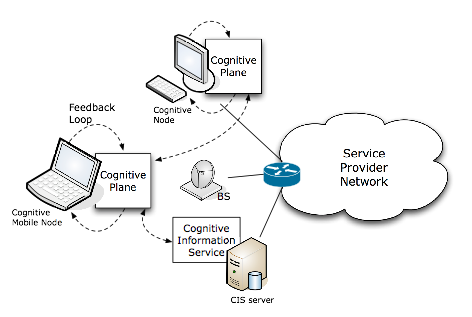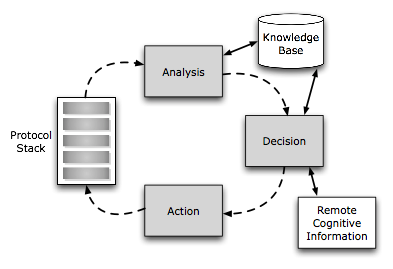The Cognitive Framework
Advancements in network technologies dramatically increased cost of management and complexity. Cognitive networking was introduced to deal with this problem, by providing algorithms for autonomous network management and protocol reconfiguration.
We propose a cognitive approach for dynamic reconfiguration of communication protocols. The proposed framework, called CogProt, aims at providing both runtime self-configuration and initial setup of protocol parameters. The self-configuration process consists in monitoring the performance and then enforcing reconfiguration of protocol parameters.
The figure following shows the elements of the cognitive framework. CogProt includes a cross-layer cognitive plane which provides self-configuration capability to network nodes. Each network node is allowed to independently decide on its own protocol setup to best match the current network conditions. The framework also includes a Cognitive Information Service (CIS) to support the exchange of cognitive information.

The architecture of the cognitive node is presented in next figure. The cognitive plane includes the self-configuration process and a knowledge base. CogProt periodically reconfigures protocol parameters based on experience acquired in random oscillations around previous setup. It monitors the performance obtained with current setup and stores this information in the knowledge base. Such information accumulated in the knowledge base is used to decide on the proper reconfiguration actions.
The cognitive plane also implements communication interfaces to provide cognitive information sharing. The decision-making process can take into account not only performance information from local knowledge base but also information obtained from neighboring nodes or from a Cognitive Information Service (CIS) running on local dedicated servers. In addition, when a node joins the network it can obtain information for initial setup of protocol parameters from a local CIS server.

The challenge in cognitive reconfiguration of parameters is how to implement performance monitoring and decision making in a simple and scalable way. In our approach, the cognitive node continuously reconfigures itself based on recent performance information. Cross-layer self-configuration capabilities are supported by a feedback loop that consists of three steps: data analysis, decision making, and action, as illustrated in the following figure.

Consider the dynamic reconfiguration of a protocol parameter P. Such parameter of interest could be, for instance, the TCP window initial value or the MAC retry limit. In the data analysis step, the cognitive plane collects performance information on the current value of the parameter P. Performance is measured in terms of this specific metric that can be a simple or compound metric, or even a utility function. The local knowledge base is built from performance information collected at each iteration of the feedback loop to assist the decision making step. In the decision making step, the cognitive plane selects the value of P that provides the best performance, and assigns this value to the mean of a normally distributed random number generator. This selection can use not only information from the local knowledge base, but also information shared by network nodes or obtained from local CIS servers. The action step consists in assigning a new random value to P. This value is obtained from the random number generator in the operation range of the parameter P.
This reconfiguration steps are repeated every interval , and it continuously adjusts the mean of the normal distribution to the value of P that provides the best performance. Besides, the employment of random variations around the best value of P enables the cognitive mechanism to test neighboring values (close to the mean), allowing adjustment of the parameter in face of changes of network conditions. It is important to clarify that the feedback loop is executed by each network node in an independent way. Besides, each node has its own local knowledge base. These features imply on lack of need of a centralized coordinating entity. Furthermore, nodes enabled with CogProt work together with nodes without CogProt enabled. This is possible because CogProt demands neither information exchange among network nodes nor changes in protocols.
Further information:
A Cognitive Approach for Cross-Layer Performance Management
IEEE Global Communications Conference (GLOBECOM), Miami, 2010.
N. Malheiros, D. Kliazovich, F. Granelli, E. Madeira, and N. L. S. da Fonseca
CogProt: A Framework for Cognitive Configuration and Optimization of Communication Protocols
2nd International Conference on Mobile Lightweight Wireless Systems (MOBILIGHT), Barcelona, 2010.
-
D.Kliazovich, N. Malheiros, F. Granelli, E. Madeira, and N. L. S. da Fonseca
For comments, requests, or suggestions, please contact us at:

